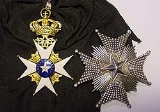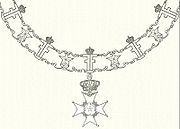
Order of the Polar Star
Encyclopedia

Swedish language
Swedish is a North Germanic language, spoken by approximately 10 million people, predominantly in Sweden and parts of Finland, especially along its coast and on the Åland islands. It is largely mutually intelligible with Norwegian and Danish...
Nordstjärneorden) is a Swedish order of chivalry created by King Frederick I of Sweden
Frederick I of Sweden
Frederick I, , was a prince consort of Sweden from 1718 to 1720, and a King of Sweden from 1720 until his death and also Landgrave of Hesse-Kassel from 1730...
on 23 February 1748, together with the Order of the Sword
Order of the Sword
The Order of the Sword is a Swedish order of chivalry created by King Frederick I of Sweden on February 23, 1748, together with the Order of the Seraphim and the Order of the Polar Star.Awarded to officers, and originally intended as an award for bravery and particularly long or useful service, it...
and the Order of the Seraphim
Order of the Seraphim
The Royal Order of the Seraphim is a Swedish Royal order of chivalry created by King Frederick I of Sweden on 23 February 1748, together with the Order of the Sword and the Order of the Polar Star...
.
The Order of the Polar Star was until 1975 intended as a reward for Swedish and foreign "civic merits, for devotion to duty, for science, literary, learned and useful works and for new and beneficial institutions".
Its motto is, as seen on the blue enameled centre of the badge, Nescit Occasum. This is Latin and means "it knows no decline". This is to prove that Sweden is as constant as a never setting star. The Order's colour is black. This was chosen so that when wearing the black sash, the white, blue and golden cross would stand out and shine as the light of enlightenment from the black surface. Women and clergy men are not called knight or commander but simply as Member (Ledamot).
After the reorganization of the orders in 1975 the order is only awarded to foreigners and members of the royal family. It is often awarded to foreign office holders (such as Prime and Senior Ministers) during Swedish state visits. It is also awarded to junior members of royal families who would not qualify for the more prestigious Order of the Seraphim.
Grades
The Order currently has five degrees:- Commander Grand Cross (KmstkNO) - Wears the badge on a collarLivery collarA livery collar or chain of office is a collar or heavy chain, usually of gold, worn as insignia of office or a mark of fealty or other association in Europe from the Middle Ages onwards....
(chain) or on a sash on the right shoulder, plus the star on the left chest; - Commander 1st Class (KNO1kl) - Wears the badge on a necklet, plus the star on the left chest;
- Commander (KNO) - Wears the badge on a necklet;
- Knight 1st Class (RNO1kl/LNO1klClergymen and women become ledamöter (Members) instead of knights) - Wears the badge on a ribbon on the left chest;
- Knight (RNO/LNO) - Wears the badge on a ribbon on the left chest.
This order also has a medal, "the Polar Star Medal".
Insignia
- The collar of the Order is in gold, consists of seven white-enamelled five-pointed star and seven crowned back-to-back monogramMonogramA monogram is a motif made by overlapping or combining two or more letters or other graphemes to form one symbol. Monograms are often made by combining the initials of an individual or a company, used as recognizable symbols or logos. A series of uncombined initials is properly referred to as a...
"F" (for King Frederick I of SwedenFrederick I of SwedenFrederick I, , was a prince consort of Sweden from 1718 to 1720, and a King of Sweden from 1720 until his death and also Landgrave of Hesse-Kassel from 1730...
) in blue enamel, joined by chains.
- The badge of the Order is a white enamelled Maltese CrossMaltese crossThe Maltese cross, also known as the Amalfi cross, is identified as the symbol of an order of Christian warriors known as the Knights Hospitaller or Knights of Malta and through them came to be identified with the Mediterranean island of Malta and is one of the National symbols of Malta...
, in silver for the Officer class and in giltGildingThe term gilding covers a number of decorative techniques for applying fine gold leaf or powder to solid surfaces such as wood, stone, or metal to give a thin coating of gold. A gilded object is described as "gilt"...
for Officer 1st Class and above; crowns appear between the arms of the cross. The central disc, which is identical on both sides, is in blue enamel, with a white-enamelled five-pointed star surrounded by the motto "Nescit occasum" (It knows no decline). The badge hangs from a royal crown.
- The star of the Order is a silver Maltese CrossMaltese crossThe Maltese cross, also known as the Amalfi cross, is identified as the symbol of an order of Christian warriors known as the Knights Hospitaller or Knights of Malta and through them came to be identified with the Mediterranean island of Malta and is one of the National symbols of Malta...
, with a silver five-pointed star at the centre. That of Grand Cross also has straight silver rays between the arms of the cross.
- the ribbon of the Order is black, the choice of this colour for the ribbon may have been inspired by the blaqck ribbon of the French Order of St. Michael, which at the time of the founding of the Order of the Polar Star was awarded in France for the reasons the Polar Star was awarded in Sweden. It has also been noted that the white cross of the Order stands in stark contrast to the black ribbon from which it hangs; since 1975 the ribbon is blue with yellow stripes near its borders (i. g., the national colours of Sweden).
- Formerly the Order also had a distinctive red and white habit worn on formal occasions such as at chapters of the Order. The habit included breechesBreechesBreeches are an item of clothing covering the body from the waist down, with separate coverings for each leg, usually stopping just below the knee, though in some cases reaching to the ankles...
, waistcoatWaistcoatA waistcoat or vest is a sleeveless upper-body garment worn over a dress shirt and necktie and below a coat as a part of most men's formal wear, and as the third piece of the three-piece male business suit.-Characteristics and use:...
, coatCoatCoat can refer to any one of the following: *Coat, a layer of a certain substance, usually paint.*Coat , the natural fur coat of an animal.*Coat , an article of clothing for humans.*Coat , the natural fur coat of a dog....
, cape and a black top hatTop hatA top hat, beaver hat, high hat silk hat, cylinder hat, chimney pot hat or stove pipe hat is a tall, flat-crowned, broad-brimmed hat, predominantly worn from the latter part of the 18th to the middle of the 20th century...
with a plumePlumePlume may refer to:In science:* Plume , the form of effluent in water or emissions in air* Eruption column, or volcanic plume, a column of hot volcanic ash and gas emitted into the atmosphere during an explosive volcanic eruption...
of white ostrichOstrichThe Ostrich is one or two species of large flightless birds native to Africa, the only living member of the genus Struthio. Some analyses indicate that the Somali Ostrich may be better considered a full species apart from the Common Ostrich, but most taxonomists consider it to be a...
and black egretEgretAn egret is any of several herons, most of which are white or buff, and several of which develop fine plumes during the breeding season. Many egrets are members of the genera Egretta or Ardea which contain other species named as herons rather than egrets...
feathers.

